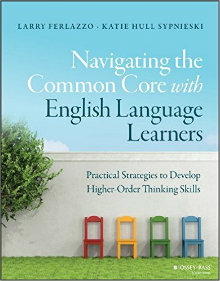How to Navigate the Common Core with ELLs
Navigating the Common Core with English Language Learners: Practical Strategies to Develop Higher-Order Thinking Skills
By Larry Ferlazzo and Katie Hull Sypnieski
(Jossey-Bass, 2016 – Learn more)

Want to learn how to better serve your English language learners (ELLs)? Want to pick up great new strategies and plans to help all of your students take ownership of their learning?
Want to better understand the Common Core State Standards (CCSS) for English language arts (ELA)? Want to do all of that in a low-stress, friendly environment?

Before I begin the review in earnest, I have to admit that I am a Larry Ferlazzo super-fan. For a long time, Ferlazzo’s blog has been my go-to spot for up to the minute information and resources that help me teach my ELLs. There is nothing else like it on the internet.
If you haven’t checked out his website for teachers, trust me, you must (fellow Ferlazzo aficionados, you know what I mean!). Once you see Larry’s resources (sample), you’ll know that anything from this educator is bound to be pure gold.
Navigating the Common Core with English Language Learners is much like the website in that it is incredibly user-friendly and carries a conversational tone projecting both care and respect for teachers, students, and the education profession as a whole.
This is less a book to be read cover to cover than a handbook to be marked up, dogged eared, covered in Post-its, and used to help teacher do the work of helping students learn.
What’s Inside
The book is divided into three main sections: an overview of the Common Core as it relates to English language learners; a section on creating the conditions that allow ELLs (and really all students) to shine; and chapters devoted to making the CCSS work for students in specific content areas.
The “Overview” Pages
The book begins with basic information about ELLs and about the Common Core Standards for ELA. While Ferlazzo and teaching colleague Hull-Sypnieski aren’t totally crazy about the CCSS and the potential effect on learners (a view shared by many teachers who serve ELLs), they are profoundly practical in their outlook. They write,
We would have identified other problems facing our students and schools as higher priorities over the lack of national standards. We’re all for having our students be ‘college and career ready,’ but we’re not sure that the socioeconomic infrastructure is there yet to support students, teachers, and schools in meeting the Common Core standards definition…. But, we live in the world as it is, not as we would like it to be, and therefore we feel the need to develop strategies to make CCSS work for our students, their families, and our schools” (p. 8).
What follows is a general overview of the ELA standards and their relationship to ESL needs. The authors offer the best primer for understanding English language proficiency (ELP) levels that I have ever seen. Ferlazzo and Hull-Sypnieski break down what it means to be in the process of learning English from the earliest beginners, to those with intermediate skills and abilities, to full-on fluency.
To illustrate the levels, they use charts that show commonly used ELP leveling systems, laying out definitions and examples from systems including WIDA, ELPA21, California ELD Standards, and others.
The “Creating Conditions” Pages
Ferlazzo and Hull-Sypnieski strongly believe that if students are to learn optimally, they must first have several social-emotional skills in place. Based on the theories that students need a measure of control over their own learning, a belief that they can be successful, a sense of connectedness to teachers and fellow learners, and an understanding of how what they learn is relevant to their lives, the authors offer lesson plans and discussions to build related skills, plans and discussions – including goal-setting, metacognition, critical thinking, creativity/innovation, and positive dispositions to learning.
While each of these topics is grounded in solid theory and/or research-based evidence, the bulk of the content is focused on realistic strategies to help students in your classroom. It is clear that Ferlazzo and Hull-Sypnieski are boots-on-the-ground teachers who know from real experience what will be helpful to teachers and learners.
Heard the term grit? Autonomy? Mindset? Resilience? These most buzzy of the buzzwords are discussed with interactive lesson plans that you can implement immediately to help set the foundations for success in your classroom.
The “Making it Work” Pages
This last “section” consists of seven resource-rich chapters: Reading, Writing, Speaking and Listening, Language, Mathematics (by contributor Wendy Jennings), Social Studies (contributor Elisabeth Johnson), and Science (contributors Caleb Cheung, Laura Prival, Claudio Bargas, and Diana Velex).
Each chapter offers a summary of what the CCSS says about the content area, a quick discussion of what that means to daily teaching and learning, and then oodles of strategies and lesson plans for helping teachers make the CCSS work for ELLs. Tech tools and illustrated examples are often provided.
The bottom line is that this book is a good investment. Ferlazzo and Hull Sypnieski definitely hit all the marks. The book provides resources and ideas in a jargon-free teacher-friendly way that few others do.
My copy of Common Core with English Language Learners: Practical Strategies to Develop Higher-Order Thinking Skills is marked up, tagged, and folded and I am ready to implement several lessons during the first weeks of school. Frankly, there can be no higher praise than that from a working teacher.
Rita Platt (@ritaplatt) is a National Board Certified teacher with master’s degrees in reading, library, and leadership. Her experience includes teaching learners in remote Alaskan villages, inner cities, and rural communities. She currently is a teacher-librarian, teaches graduate courses for the Professional Development Institute and writes for We Teach We Learn.

































